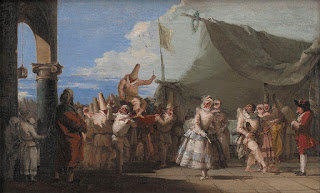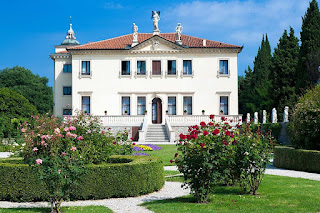Famous artist’s son developed his own style
 |
| Many of Tiepolo's works, such as this carnival scene in Venice, featured the comic character Pulcinella |
Also known as Giandomenico Tiepolo, he was one of the nine children born to the artist Giovanni Battista Tiepolo and his wife, Maria Guardi, the sister of painters Francesco and Giovanni Guardi.
Perhaps not surprisingly, Giandomenico inherited the talent to go into the same profession as his father and uncles and, by the age of 13, he had become the elder Tiepolo’s chief assistant. His younger brother, Lorenzo, also became a painter and worked as an assistant to his father.
By the age of 20, Giandomenico was already producing his own work for commissions. However, he continued to accompany his father when he received his major commissions in Italy, Germany and Spain.
He assisted his father with a grand stairwell fresco for a prince’s palace in Wurzburg in Bavaria in 1750 and with decorations for the Villa Valmarana ai Nani in Vicenza in 1757 and the Royal Palace of Madrid in 1770.
The elder Tiepolo died while in Madrid and after Giandomenico returned to live in Venice, his own style of painting began to develop. His portraits and scenes of life in Venice were realistic and characterised by movement and his use of colour. He drew inspiration for his paintings from the lives of both peasants and aristocrats.
_-_VIA_CRUCIS_II_-_Jesus_carries_his_cross_by_Giandomenico_Tiepolo.jpg) |
| One of the panels from the Via Crucis cycle, in the Oratory of the Crucifix at San Polo |
He produced more than 100 separate sketches of Pulcinella, a physically deformed clown who was the standard character of commedia dell’arte in Venice and later became the Punch in Punch and Judy. The sketches were created as entertainment for children, but also poked fun at the pretensions and behaviour of the viewers of Pulcinella’s shows.
He accepted commissions for religious paintings also. Many can be seen in the Chiesa di San Polo in Venice, including the 14 panels of his Via Crucis cycle, which can be seen in the adjacent Oratory of the Crucifix.
Frescoes that Giandomenico painted for the Tiepolo family villa at Zianigo near Mirano were removed from the walls of the building at the beginning of the last century and nearly sold to a French buyer, but the export of the paintings was blocked by an Italian Government minister. They were subsequently acquired by the city of Venice and put on display at Ca’ Rezzonico on the Grand Canal, in a replica of their original arrangement at the villa.
The paintings were executed between 1759 and 1797 solely for the entertainment of Giandomenico and his family. The ones featuring Pulcinella were the last to be painted and are perhaps the most famous of the cycle. Giandomenico was said to have been obsessed by the commedia dell’arte character during the last years of his life and is thought to have used him in his paintings as a vehicle to reflect his own irreverent and sarcastic spirit.
Giandomenico Tiepolo died in Venice in 1804, aged 76.
 |
| The Villa Valmarana ai Nani in Vincenza, where Tiepolo and his father painted frescoes |
Villa Valmarana ai Nani was built in 1669 near the gates of the city of Vicenza. The villa takes its name from the 17 stone sculptures of nani, dwarves, that once decorated the garden and have now been placed on the walls surrounding the villa. It is believed they were sculpted by Francesco Uliaco based on drawings by Giandomenico Tiepolo. The villa is famous for the frescoes by Giambattista and Giandomenico Tiepolo in the palazzina, owner’s residence, which were commissioned by Giustino Valmarana in 1757. The present day Valmarana family still live in the villa.
 |
| Frescoes by Giandomenico Tiepolo on display at Ca' Rezzonico, the palace on the Grand Canal |
Ca’ Rezzonico on the Grand Canal in Venice, which now houses Giandomenico Tiepolo’s frescoes on its second floor, was built in the 16th century to a design by the architect Baldassare Longhena. Before the building was complete the architect died and the unfinished construction was later bought by Giambattista Rezzonico, who commissioned Giorgio Massari to complete it. In the 19th century it was purchased by Pen Browning, the painter son of the poet, Robert Browning. The poet died there during a visit in 1889. The frescoes removed from Giandomenico’s villa went on display in Ca ‘Rezzonico in 1936. The palace is also now home to the Museum of 18th Century Venice.
Also on this day:
1580: The death of Emanuele Filiberto, Duke of Savoy
1585: The death of Venetian composer Andrea Gabrieli
1860: The birth of New York crime fighter Joe Petrosino
No comments:
Post a Comment